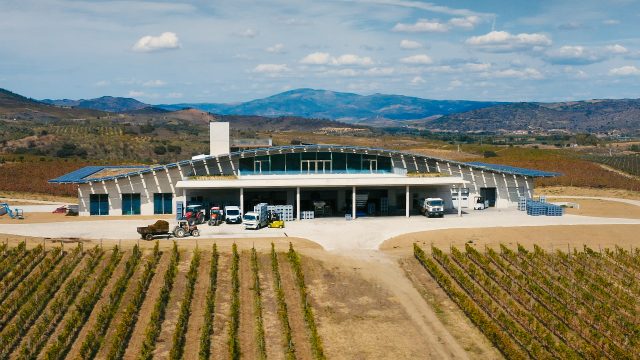This website uses cookies so that we can provide you with the best user experience possible. Cookie information is stored in your browser and performs functions such as recognising you when you return to our website and helping our team to understand which sections of the website you find most interesting and useful.
Symingtons celebrate 2023 harvest at new Douro DOC winery
Symington Family Estates has given its overview of the 2023 harvest which also saw the opening of its €12 million Adega do Ataíde winery.

A statement from Charles Symington, head winemaker and production director, revealed that after six years of planning and a sizeable investment, the new winery, located at the group’s Vilariça Valley estate, Quinta do Ataíde, in the east of the Douro, had opened.
The winery, which will produce still reds from the Quinta do Ataíde and Quinta do Vesúvio estates, as well as some other expressions, has been designed with environmental friendliness in mind. In addition to solar panels and an on-site water treatment facility (which will utilise captured rainwater and treated wastewater), the new facility is also a gravity flow winery, meaning that mechanical pumps are not required to transport the juice around the winery. The winery has already been approved for the LEED certification process (Leadership in Energy and Environmental Design) which will make it the first LEED certified winery in Portugal and the first in the world to attain the comprehensive LEED v4 level. The winery has been approved to submit for LEED certification, it hasn’t received it yet.
Symington said of the new facility: “2023 was our debut vintage and I am very impressed by how our winemaking team adapted to working with the new state-of-the-art equipment, and the quality of the wines that we produced this harvest. The first 10 days were dedicated to running trials, equipment testing and fine-tuning procedures. While we encountered a few teething problems, the team was quick to find solutions and soon settled into a good rhythm for the rest of the harvest. This new winery hasn’t just delivered what we had hoped for, it’s surpassed all our expectations and we are excited by the opportunities it will give us in future.”
As for the harvest in general, Symington noted that “on the eve of the 2023 harvest we were well placed to have one of the highest quality vintages in recent years”, pointing out that abundant rain in winter and good temperatures for ripening in the summer were highly beneficial.
Harvesting began in the Douro on 21 August with the picking of the Viosinho from Quinta das Netas in the Pinhão Valley and the Tapadinha vineyard in the Rio Torto Valley, both higher than 500 metres above sea level. Verdelho from Quinta da Fonte Souto in the Alto Alentejo region, east of Lisbon, was picked from 7 August. Back in the Douro, Tinta Roriz at Quinta do Ataíde, used in the production of Altano Rosé, was picked soon after. Between bouts of rain in September, most of the finest parcels of Touriga Nacional were picked, which Symington said “performed especially well with good maturations and near perfect phenolic ripeness”.
The final burst of rain, from 15-17 September, meant that the harvested did have a somewhat damp conclusion that slightly affected quality.
“Although 2023 may not have been the exceptional harvest that we were expecting,” Symington acknowledged, “after tasting the wines I am very pleased with the quality of what we have made – particularly from our estates in the Cima Corgo sub-region. The best wines are beautifully balanced with excellent colour and freshness.”
Total production at Symington Family Estate’s Douro vineyards was 30% above that of 2022, but in line with the average for the decade. Average yields per vine were 1.15 kilograms, slightly above the 10 year average of 1.06kg.
However, citing the Douro Deserves Better open letter, which the family have been keen supporters of, Symington said: “We started our Douro DOC project from scratch in 1999 and, over the last two decades, we have developed an exciting portfolio of wines from the region – selling almost 270,000 cases in 2022. However, the Douro faces a significant challenge, with an outdated regulatory system allowing grapes for Douro DOC wine to be transacted on an open market, often below cost of production with excess supply. By comparison, Port production is highly regulated through the benefício system. This is impacting the socio-economic sustainability of the region and the future of Douro wines in international markets.”
“We believe that it is through innovative projects like our new Ataíde winery – and the positive impact that it will have on the quality of our premium wines – which will allow us to project the reality of our region and the value of its wines, with the goal of growing the Douro DOC category. Nevertheless, without a new regulatory system that covers port and Douro DOC, the imbalance will persist,” he continued.
Related news:
Which grape varieties are best for Douro still wines?
Adrian Bridge: Principal’s high-end Bairrada could be ‘the Vega Sicilia of Portugal’
Related news
All the medallists from the Global Fortified Masters 2024

